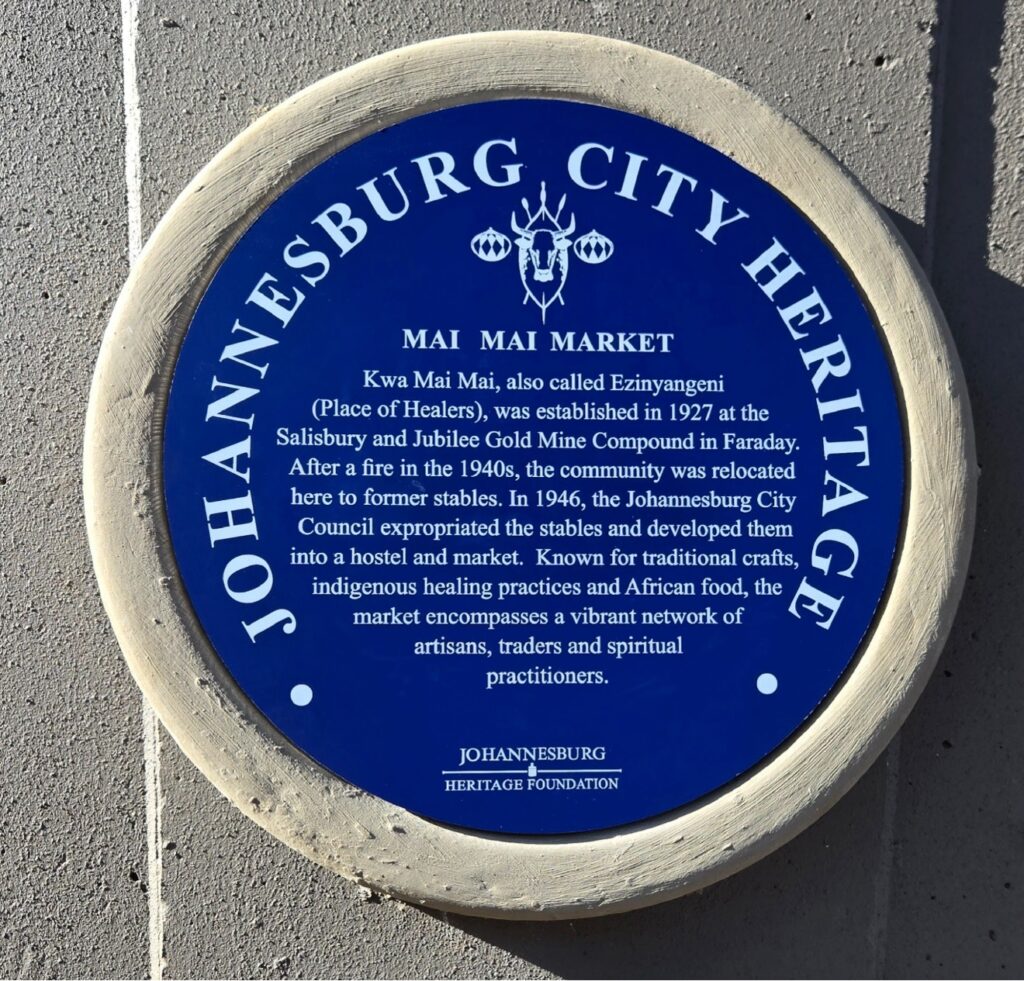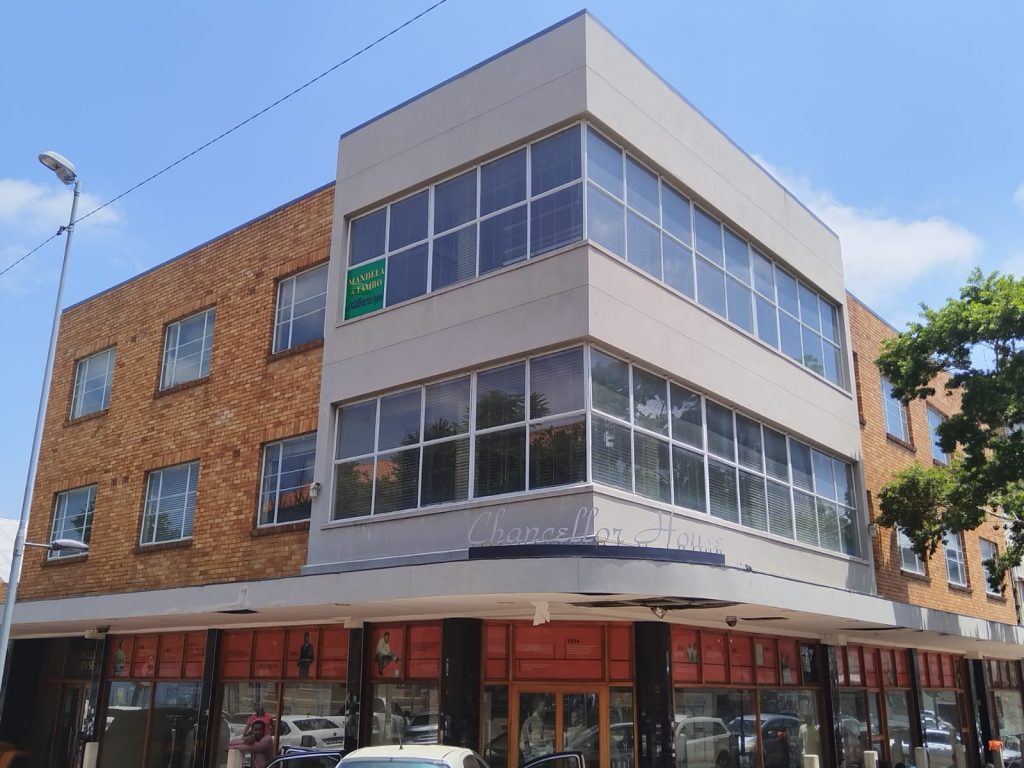Kwa Mai Mai Market, located under the highway at the corner of Anderson and Berea Streets in Johannesburg, represents one of the city’s oldest and most culturally significant informal trading hubs. Originating in the early 20th century and commonly referred to as “Ezinyangeni” (the Place of Healers), the market has evolved into a vibrant space of spiritual practice, artisanal craftsmanship, and traditional commerce. Its physical structure initially built in the 1880s as horse stables has been adaptively reused by generations of African traders and healers. The site now comprises a dense and organically developed network of stalls, alleys, and ritual spaces that reflect longstanding indigenous practices. Characterized by the sale of traditional medicine, handcrafted items, and traditional African food, Kwa Mai Mai operates both as a marketplace and a living archive of African resilience, spirituality, and socio-economic continuity.
Long before the shimmering skyline of Johannesburg came into being, the surrounding area was home to various African communities, living off the land through farming, cattle herding, and carrying on age-old spiritual practices. Their way of life would face dramatic upheaval with the onset of colonialism and the discovery of gold in 1886 on the Witwatersrand. That event triggered a massive influx of migrant laborers into the area, transforming Johannesburg almost overnight into a bustling mining city. African men from across Southern Africa including KwaZulu-Natal, the Eastern Cape, Lesotho, and the northern Transvaal arrived in search of work under harsh conditions that often denied them formal housing and land ownership.
The former Salisbury and Jubilee Gold Mine Compound, located near the intersection of Wemmer, Jubilee Road, and von Wielligh Street present-day Faraday, was acquired by the Johannesburg municipal authorities in 1927 for £5,500 from the Centre Syndicate, following the mine’s closure prior to the First World War. The site was subsequently repurposed as a municipal lodging facility intended for Black laborers engaged in short-term or irregular employment within the city. These workers, referred to as "daily laborers," were required to possess special permits that were renewed monthly and signed by compound officials, as they lacked fixed employers. Within this compound environment, the earliest iteration of what would later evolve into the Mai Mai Bazaar began to emerge.
Most interpretations of the market’s name trace its origins to Mr. Saul Msane, a mine manager reputed to have exclaimed “Maye Maye!” a Zulu expression of sympathy or alarm whenever injured miners were brought to the surface. Msane, a newspaper editor and founding member of the South African Native National Congress (SANNC) in 1912, was an early advocate for African political rights. He moved to the Transvaal in 1907, where he worked as a mine manager responsible for recruiting African laborers from rural areas. Although the Mai Mai Market would later undergo various transformations, its name endured, becoming a symbolic repository of the market’s layered history rooted in labor migration, survival strategies, and community formation.
From its inception, Mai Mai functioned as more than just a shelter; it was a vibrant commercial and artisanal hub. A diverse array of traders and craftsmen sustained their livelihoods within its precincts, including leather-workers, snuff manufacturers, bangle and sandal makers, carpenters, and traditional healers. Leather and bangle artisans, in particular, were known for producing intricate ceremonial regalia used by mine dance teams, with goods frequently transported by foot to other mining compounds across the Witwatersrand. The market offered a range of specialized items: sandals crafted from repurposed car tires, wooden kists inlaid with mirrors and traditional African motifs, and finely ground snuff composed of dried tobacco, aloe, and medicinal herbs. Together, these crafts formed a distinctive and enduring network of trade that reflected the ingenuity and resilience of Johannesburg’s informal economy.
The relocation of the Salisbury and Jubilee Compound to its current site in Johannesburg’s City and Suburban area was precipitated by a devastating fire in the 1940s. The new location, situated at the intersection of Berea and Anderson Streets, was originally developed in the 1880s as horse stables intended to support Johannesburg’s burgeoning transport and mining infrastructure. With the city’s rapid industrialization and modernization, these stables were gradually abandoned, their original utility rendered obsolete. In the absence of formal redevelopment initiatives and immediate commercial interest, the derelict site was informally appropriated by a group of migrant men traders, traditional healers, and artisans who sought both shelter and continuity in their economic and spiritual practices.
Despite lacking official sanction, their presence was largely uncontested, owing to the site’s marginal economic value. These occupants exercised informal custodianship over the space, assuming the dual role of traders by day and night watchmen by night. This collective vigilance fostered a sense of community security and legitimacy. However, as apartheid legislation, notably the Group Areas Act, intensified in the mid-20th century, Kwa Mai Mai came under increasing pressure, as the state sought to regulate, displace, and control informal Black urban settlements.
In 1946, the Johannesburg City Council acquired the land from the Transvaal Graphite Company through expropriation. The intention was to formalize the area into so-called “native hostels” to accommodate the growing number of African migrants arriving in Johannesburg, categorized and housed according to ethnic groupings in line with segregationist policy. The compound was subsequently formalized into a hostel and designated trade zone with 300 beds, where stall owners and their employees could operate within a regulated framework.
From the 1940s to the 1960s, informal food trading began to flourish in the area. Women, often linked to the traders and traditional healers, began selling traditional meals such as mogodu (tripe), phuthu (crumbled maize porridge), and shisa nyama (grilled meat), catering to both workers and visitors. By the 1970s through to the 1990s, this culinary tradition had become integral to Kwa Mai Mai’s identity, offering more than nourishmentit provided cultural continuity and a sense of community under the repressive conditions of apartheid.
By the mid-1980s, Kwa Mai Mai’s cultural and historical significance began to receive formal recognition. In the context of Johannesburg’s centenary celebrations in 1986, the site was identified as one of the city’s top 100 heritage locations worthy of preservation.
The promulgation of the Traditional Health Practitioners Act in 2007 marked a milestone in the official recognition of indigenous healing systems in South Africa, affirming Kwa Mai Mai’s dual role as both a cultural site and a functional space within the broader healthcare landscape.
In the post-apartheid period (2000s to present), Kwa Mai Mai has continued to evolve amidst the forces of urban redevelopment and cultural tourism. While increased visibility and commercial opportunity have benefitted many traders and practitioners, concerns persist regarding the commodification of sacred practices and the potential erosion of cultural authenticity.

National Heritage Resources Act, 1999: Provisional Protection status, July 2011.

A culmination of research gathered over many years, the Online Johannesburg Heritage Register is being launched on Nelson Mandela Day 18 July 2025.
Among the many heritage sites featured is Chancellor House, the downtown offices of Mandela and Tambo Attorneys in the 1950s. After having been vacant and shuttered for more than a decade, this iconic building is being revived and brought to life once again as offices for the Community Development Department, which oversees the City’s Arts, Culture & Heritage Services.